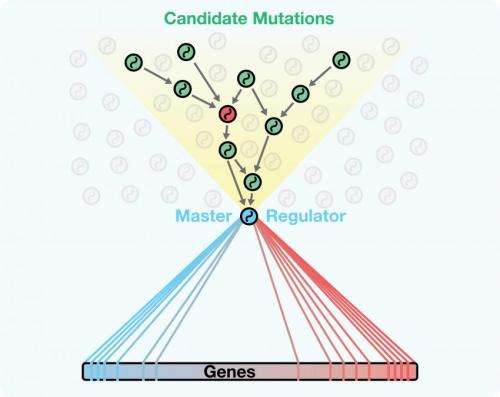New computational approach finds gene that drives aggressive brain cancer

Using an innovative algorithm that analyzes gene regulatory and signaling networks, Columbia University Medical Center (CUMC) researchers have found that loss of a gene called KLHL9 is the driving force behind the most aggressive form of glioblastoma, the most common form of brain cancer. The CUMC team demonstrated in mice transplants that these tumors can be suppressed by reintroducing KLHL9 protein, offering a possible strategy for treating this lethal disease. The study was published today in the online issue of Cell.
The team used the same approach to identify mutations and heritable variants that have been linked to breast cancer and Alzheimer's disease, suggesting that the algorithm, combined with the researchers' sophisticated computer models of cellular regulation, is a powerful method for identifying genetic drivers of a wide range of diseases.
"This algorithm adds a new dimension to our ability to identify the genetic causes of complex disease. When combined with other tools that our lab has developed, it will help identify many more genes that hold potential as genetic biomarkers of disease progression and targets for treatment," said study leader Andrea Califano, PhD, the Clyde and Helen Wu Professor of Chemical Biology (in Biomedical Informatics and the Institute for Cancer Genetics), chair of the Department of Systems Biology, and director of the JP Sulzberger Columbia Genome Center, at Columbia's College of Physicians and Surgeons.
In previous studies, Dr. Califano and his colleagues used high-power computer models to demonstrate that certain types of cancer have highly conserved "master regulators"—genes whose individual or synergistic activity is necessary for disease to develop and persist. However, these models provided no information on the key genetic mutations that presumably drive the abnormal activity of these master regulators.
In the current study, the team combined its existing computational tools with a new algorithm called DIGGIT (for Driver-Gene Inference by Genetical-Genomic Information Theory), which "walks" backward from the master regulators to find the genetic events that drive cancer.
"Conventional techniques, like genome-wide association studies, must test all possible genetic mutations and variants in a disease cell, compared with a normal cell," said lead author James C. Chen, PhD, a postdoctoral research scientist in Dr. Califano's laboratory, who developed DIGGIT. "These can number in the tens to hundreds of thousands. As a result, based on the number of patients we have profiled, we have sufficient statistical power to identify only the most striking mutations. The DIGGIT algorithm, combined with what we know about regulatory events in the cell, can help us sort through this mass of data and identify critical hidden mutations that otherwise would have gone undetected."
The new approach was tested on mesenchymal glioblastoma, the most aggressive subtype of the disease, by jointly analyzing the gene expression and mutational profile data of more than 250 patients collected by the Cancer Genome Atlas consortium.
The CUMC team found two genes—C/EBPδ and KLHL9—that appear to activate glioblastoma's master regulators. C/EBPδ, had already been identified by the labs of Dr. Califano and of Antonio Iavarone, MD, professor of neurology and of pathology & cell biology (in the Institute for Cancer Genetics), as a master regulator of the disease, so the researchers focused on KLHL9, which had never been tied to this or any other form of cancer.
In subsequent laboratory studies, the researchers reactivated the defective KLHL9 gene in aggressive glioblastoma cells, which was sufficient to lose the mesenchymal phenotype. When KLHL9 protein was reintroduced into mice receiving direct transplants from patients with mesenchymal glioblastoma, their tumors regressed, providing further evidence that KLHL9 mutations (which were found in 50 percent of the mesenchymal glioblastoma patients), are directly responsible for driving this cancer subtype.
DIGGIT may be applicable to other complex diseases. In further studies by the Califano team, the algorithm identified 35 genes as drivers of breast cancer. Of the 25 genes previously identified in the literature, 19 (76 percent) were identified by DIGGIT, confirming that the algorithm is capable of capturing driver mutations in other types of cancer. The analysis also revealed several novel genes that may warrant further investigation. In a study of Alzheimer's disease, DIGGIT found 14 genetic variants that appear to drive the condition, including the APOE locus, a well-known variant associated with Alzheimer's, and TYROBP, a gene also validated as an Alzheimer's risk variant. DIGGIT also identified novel variants, including those in four genes in the integrin pathway, that had not been previously connected with the disease and that are currently being investigated.
"It's important to stress that this constitutes an important improvement over traditional gene-association studies. The latter can identify statistical associations between mutations and disease, but cannot explain how the mutation drives that effect," said Dr. Califano. "Because DIGGIT identifies disease-causing genes by tracing their aberrant activity through the regulatory network of the cell, it provides direct information on the specific molecular interactions through which a genetic mutation causes disease—the 'mechanism.' In traditional research, this process can take years, if not decades."
"Even in our studies of breast cancer and Alzheimer's disease, where the goal was simply to show that DIGGIT could identify mutations and variants missed by conventional statistical methods, the algorithm identified the key molecular regulators and pathways through which these mutations likely work to drive disease, adding significant new knowledge that can be rapidly tested in the lab" Dr. Chen said.
Columbia University Medical Center (CUMC) researchers have combined existing computational tools with a new algorithm called DIGGIT (for Driver-Gene Inference by Genetical-Genomic Information Theory), which "walks" backward from the master regulators to find the genetic events that drive cancer. (Image credit: CUMC)
More information: The article is titled, "Identification of causal genetic drivers of human disease through systems-level analysis of regulatory networks."

















